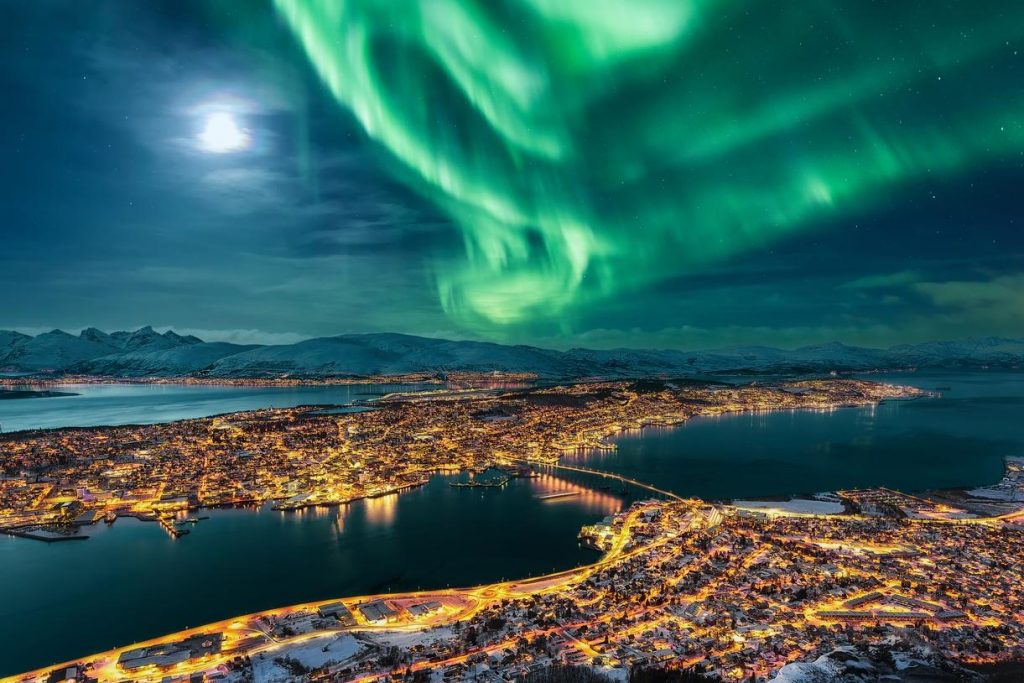Northern Norway has become one of Europe’s fastest-growing travel regions. Winter tourism has surged in popularity over the past decade, driven by travelers seeking northern lights experiences, Arctic culture and wildlife encounters far above the Arctic Circle.
Amid this growth, Tromsø has emerged as the region’s star attraction. But while the city’s tourism economy has flourished, other destinations across the north have faced very different realities.
Some are struggling to cope with demand, while others are struggling to attract it at all. The boom is real, yet the benefits are uneven.
Why Tromsø Is Having A Moment
On winter evenings in Tromsø, tour buses fill the streets and travelers gather on the harborfront to head out in search of the aurora. It has become one of the most recognizable winter destinations in Europe, and it’s pretty popular during the summer too.
Winter travelers come for northern lights safaris, husky sledding and whale watching expeditions. As such, tourism infrastructure is now well developed, with a full range of hotels, activity providers and transportation services.
Connectivity has played a decisive role. Tromsø enjoys frequent daily flights from Oslo, as well as seasonal or year-round direct flights from London, Frankfurt, Paris, Amsterdam, Copenhagen and more. The airport is a straightforward entry point to the Arctic, making weekend trips feasible.
But the rapid rise in visitor numbers has pushed the city’s infrastructure to its limits. Last winter, Tromsø Airport handled more than 300,000 international passengers in the peak season.
Airport management expects that number to grow again this winter, despite already stretched capacity. The combination of winter storms, tight flight schedules and high arrival volumes in the new but already too small international terminal still threatens bottlenecks.
Accommodation costs reflect the pressure. Hotel occupancy remains consistently high and a standard hotel room in peak northern lights season can now exceed $350.
Yet benefits are also clear. Restaurants are busy. Guides and outdoor operators have stable winter employment. New hotels continue to open, including large upscale properties, signalling investor confidence in the long-term strength of Arctic tourism.
The challenge in Tromsø is not attracting visitors. It is managing growth in a way that maintains livability and sustainability in a compact city located in a sensitive northern environment.
In Kirkenes, Access Determines Demand
Fly east from Tromsø toward the Russian border and the situation looks very different. Kirkenes offers many of the same winter activities as its better-known neighbor, along with unique draws such as king crab safaris and the activities available at the Kirkenes Snowhotel.
It also has historical tourism tied to the Norwegian-Russian border region and the Second World War. But, what Kirkenes does not currently have is easy access, despite its status as turnaround port for the Norwegian coastal cruise ferries.
The recent cancellation of evening flights from Oslo has become a significant concern for local tour operators. Without a late arrival option, many tourists must now spend an overnight stop in Oslo, adding time and cost.
Local operators told the Barents Observer that some group bookings have already been cancelled for the upcoming season for that reason alone.
Tourism in Kirkenes is particularly dependent on winter. Losing visitors in those months has an outsized effect on the town’s economy.
Accommodation capacity is another constraint. While Tromsø has seen several new hotels open over the past five years, Kirkenes has not added significant new capacity in decades. Hotel availability is limited at peak times. That makes scaling tourism difficult even when demand exists.
Lofoten Tries To Manage Overtourism
If Tromsø is managing growth and Kirkenes is trying to ensure access, the Lofoten islands are dealing with a different question: how many visitors is too many?
Lofoten’s dramatic mountains, fishing villages and white-sand Arctic beaches have turned the region into a global visual icon. Social media has amplified that visibility. Hikes like Reinebringen that were once known mostly to Norwegians now draw international travelers in large numbers, particularly in summer.
However, the islands’ infrastructure was never designed for such volume. Roads are narrow and winding. Parking is limited. Public facilities, such as restrooms and waste management stations, have been under strain.
Local residents have reported traffic congestion in villages, while some have voiced concerns over visitor behavior in fragile landscapes, including off-path hiking and wild camping in unsuitable areas.
The government approved a new tourism tax framework in 2025 that will allow municipalities to introduce a levy on accommodation. The revenue is intended to fund tourism infrastructure projects that benefit residents and visitors, including trails, signage and environmental management.
For Lofoten, where the discussion about sustainable tourism has become increasingly urgent, the mechanism may help municipalities better cope with high demand.
Yet taxation alone will not resolve deeper questions about capacity, zoning and visitor flow. Lofoten remains spectacular, but it is learning in real time how to safeguard a landscape that hundreds of thousands of people want to see.
Northern Norway’s tourism growth reflects global travel trends. Travelers are looking for cooler destinations in warmer seasons, and for nature-led travel experiences that feel authentic. The Arctic delivers that.
But geography, air connections, accommodation capacity and local planning decisions shape how each destination is experiencing the boom.

